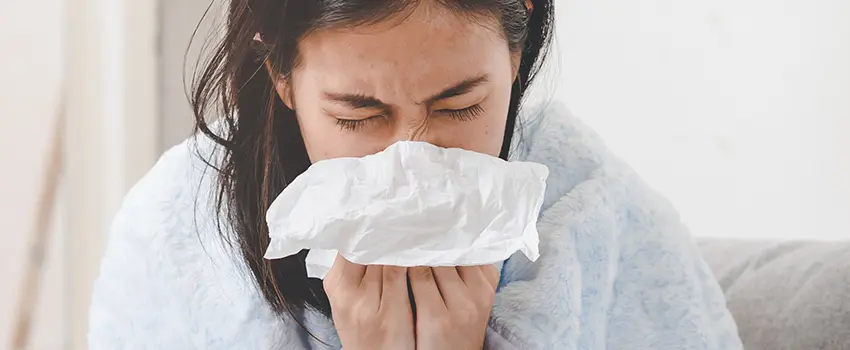As the seasons change and the temperature drops, it’s not uncommon to hear warnings about the arrival of cold and flu season. During this time, many people become more wary of their health and take extra precautions to avoid getting sick.
However, amidst the heightened awareness, numerous myths and misconceptions about this season have been perpetuated over the years. American Family Care (AFC) debunks these myths and separates fact from fiction, enabling you to make informed decisions about your health.
Table of Contents

Myth 1: Cold Weather Causes Colds and the Flu
One of the most pervasive myths surrounding flu season is the belief that cold weather directly causes illness. Many people associate the drop in temperature with an increased likelihood of catching a cold or the flu. However, this common misconception is not supported by scientific evidence.
The truth is that cold weather does not directly cause colds or the flu. These illnesses are primarily caused by viruses, specifically rhinoviruses for the common cold and influenza viruses for the flu. While it is true that these viruses tend to be more prevalent during the colder months, the correlation between temperature and illness is not a causal relationship.
So why do we see an increase in colds and the flu during winter? Firstly, viruses tend to thrive and spread more easily in cold and dry conditions. The low humidity levels during winter allow viruses to survive longer in the air, increasing the chances of transmission. Additionally, in colder weather, people tend to spend more time indoors in close proximity to others, providing ample opportunities for viruses to spread from person to person.
Myth 2: Going Outside with Wet Hair or Without a Jacket Can Make You Sick
We’ve all heard the admonishments from well-meaning friends or family members warning us not to go outside with wet hair or without a jacket, as it allegedly increases the likelihood of getting sick. This belief has been ingrained in popular culture for decades, but is there any truth to it?
Contrary to this myth, simply stepping outside with wet hair or without proper clothing does not directly cause illness. Colds and the flu are caused by viruses, as mentioned earlier, and exposure to cold temperatures alone does not make you more susceptible to catching these viruses. In fact, the virus’s actual transmission from an infected person to a healthy individual is what leads to illness.
However, there is a kernel of truth behind this myth. Going outside without adequate protection in cold weather can make you feel uncomfortable and potentially weaken your immune response, making it slightly easier for a virus to take hold.
Cold temperatures may cause vasoconstriction (narrowing of blood vessels) in the body, which could reduce the circulation of immune cells in the respiratory system temporarily. However, it’s important to note that this effect is generally minor and not a primary cause of illness.
Myth 3: Vitamin C Prevents Colds
When it comes to preventing and treating colds, one popular belief that has persisted for years is that taking high doses of vitamin C can ward off the common cold. Many people reach for vitamin C supplements or load up on citrus fruits at the first sign of a sniffle in the hopes of boosting their immune system and avoiding illness. But does vitamin C really live up to its reputation as a cold-fighting remedy?
While vitamin C is indeed an essential nutrient that plays a crucial role in supporting overall immune function, the evidence linking its supplementation with a decreased risk of colds is not as strong as commonly believed.
Myth 4: Antibiotics Are Effective Against Colds and the Flu
Antibiotics are often hailed as a go-to solution when it comes to treating illnesses. However, it is important to understand that antibiotics are specifically designed to combat bacterial infections- not viral infections like colds and the flu.
Yet, there is a common misconception that taking antibiotics can help alleviate the symptoms or speed up recovery from colds and the flu. This widespread belief is, in fact, a myth that needs to be debunked.

Myth 5: The Flu Vaccine Can Give You the Flu
One of the most persistent myths surrounding the flu vaccine is the belief that receiving the vaccine can actually give you the flu. This misconception has led to hesitancy and skepticism among some individuals when it comes to getting vaccinated. However, it is essential to understand that this belief is entirely false.
The flu vaccine is formulated to stimulate an immune response that protects against specific strains of the influenza virus. It contains either an inactivated virus or viral proteins that cannot cause the flu. The vaccine cannot replicate or cause a full-blown infection.
Some people may find they experience mild side effects after receiving the flu vaccine. These side effects can include a low-grade fever, soreness at the injection site, or muscle aches. However, these symptoms are not the flu itself. They are a result of the body’s immune response to the vaccine, which indicates that the vaccine is working as intended.
Head to an AFC Location for Affordable Treatment and Walk-in Flu Shots
When it comes to addressing patient healthcare needs during the colder months, AFC is a trusted and convenient option. AFC provides affordable treatment for a wide range of illnesses, including the flu, and offers urgent care flu shots to help protect you and your loved ones.
AFC understands the importance of accessible healthcare, particularly during the peak of cold and flu season.
Are you in need of affordable and convenient cold or flu treatment services? Head to an AFC location today for quick, professional medical attention!!
